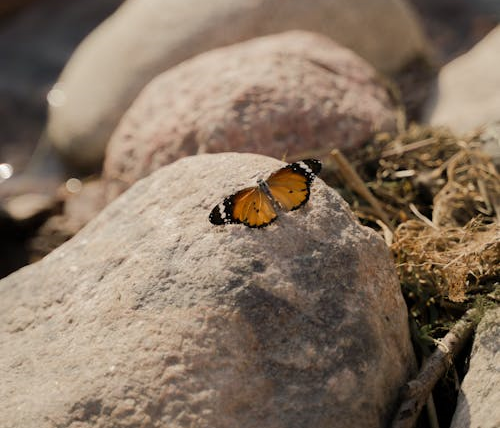“A butterfly’s wings may be delicate, but they carry the weight of transformation.”
– Unknown
Well-known for their incredible seasonal journeys and striking appearance, these butterflies play an important role in pollination and serve as symbols of change and flexibility.
Now let’s jump into the biology, conservation efforts, cultural significance, and future research directions concerning Monarch butterflies.
Part 1: Biology and Ecology of Monarch Butterflies
“Butterflies are symbols of hope, transformation, and the impermanence of life.”
– Unknown
Taxonomy and Classification
Monarch butterflies belong to the family Nymphalidae and subfamily Danainae. The genus Danaus includes other species like the Viceroy butterfly, with which Monarchs share Müllerian mimicry—a mutual resemblance that helps both species avoid predators. Monarchs, scientifically named Danaus plexippus, are easily recognizable by their bright orange and black wing patterns.
Life Cycle and Morphology
Monarchs undergo complete metamorphosis, developing through four stages:
- Egg
- Larva (caterpillar)
- Pupa (chrysalis)
- And adult
Females lay eggs on milkweed plants, the only food source for larvae. After hatching, larvae feed greedily, passing through several instars (growth stages) before pupating.
The cocoon or pupal stage completes in eclosion, where the adult butterfly emerges. Monarchs display tetrachromatic vision, allowing them to see a wide range of colors and efficiently locate nectar sources and mates.
Migration Patterns
Monarchs in eastern North America undertake one of the most extraordinary journeys in the animal kingdom, traveling up to 3,000 miles to hide away in the Oyamel fir forests of central Mexico, for the most part within the Mariposa Monarca Environment Reserve.
Western inhabitants migrate to coastline California. These migrations are influenced by environmental indications and genetic biases, ensuring the survival of the species across generations. Hide away or overwintering locations are crucial for their continued existence, offering a suitable atmospheric condition and protection from harsh winter conditions.
Part 2: Conservation Efforts and Challenges
“The butterfly’s journey is a reminder that growth often comes from struggle.”
– Unknown
Historical and Recent Conservation Initiatives
The declining Monarch population has encouraged major conservation efforts. The Pollinator Health Task Force, established through a presidential “memo” by President Barack Obama, focuses on improving pollinator health, including Monarchs.
Key federal agencies like the Environmental Protection Agency (EPA), U.S. Department of Agriculture (USDA), U.S. Department of the Interior (USDI), and the U.S. Fish and Wildlife Service (FWS) collaborate on many ideas or project to protect Monarch habitats and ensure their recovery.
Legislation and Policies
Several legislative measures aim to protect Monarch butterflies. The Fixing America’s Surface Transportation (FAST) Act includes requirements for creating pollinator-friendly habitats along highways.
The SAFE Initiative promotes sustainable roadside management practices. Additionally, the Pollinator Research Action Plan outlines strategies to encourage pollinator health through research and habitat restoration.
Non-Governmental Organizations and Citizen Science
Non-governmental organizations (NGOs) play an essential role in Monarch conservation.
The Sierra Club, Center for Biological Diversity, Xerces Society, and WWF-Mexico spearhead multiple initiatives, from habitat restoration to public education.
Citizen science projects, such as labeling programs and the forming of Monarch Waystations, engage the public in conservation efforts. These waystations provide critical breeding and nectaring habitats for Monarchs during their migrations.
Challenges and Threats
Monarch butterflies face numerous challenges, including:
- Habitat loss due to the process of the formation and growth of cities
- Agricultural expansion
- Deforestation
The extensive use of herbicides and genetically modified crops has led to the decay of milkweed, crucial for Monarch larvae.
- Predation by hemipteran bugs
- Tachinid flies
- Braconid wasps
- Along with diseases like Ophryocystis elektroscirrha (OE), further threaten their survival.
Hostile species, such as certain milkweed selections, can also negatively impact Monarch populations by providing unsuitable habitat conditions.
Part 3: Cultural Significance and Symbolism
“Butterflies are a testament to the power of transformation and the beauty that can arise from it.”
– Unknown
Monarch Symbolism
Monarch butterflies hold deep spiritual and cultural significance. They symbolize transformation and rebirth, mostly linked with the Day of the Dead (Dia de los Muertos) in Mexican culture.
Monarchs are believed to be the souls of deceased loved ones returning to visit the living.
In Native American traditions, Monarchs represent strength and change.
Christian symbolism also holds Monarchs as symbols of revival and eternal life.
Monarch Butterflies in Literature and Media
Monarch butterflies have encouraged many works of literature and media.
Barbara Kingsolver’s novel “Flight Behavior” shows the effect of climate change on Monarch migrations, while the IMAX film “Flight of the Butterflies” covers their incredible journey.
These portrayals have considerably raised public awareness about the sad state of Monarchs and the need for safeguarding.
Monarch Butterfly in Art and Tattoos
Monarch butterflies are popular subjects in art and tattoos, symbolizing change, beauty, and flexibility.
Their striking colors and patterns make them a favorite among artists, and their symbolic meanings resonate deeply with individuals who choose to get Monarch tattoos.
Part 4: Future Directions and Research
“A butterfly’s wings are a symbol of the delicate balance of life.”
– Unknown
Ongoing Research and Genetic Studies
Research on Monarch butterflies continues to uncover important information about their biology and migration.
Genome sequencing of Danaus plexippus provides understandings of their genetic makeup, helping scientists understand the genetic factors effecting migration and adaptation.
Studies on genetic modification aim to improve Monarch conservation by developing strong and tough populations capable of flourishing in changing environments.
Innovative Conservation Strategies
Ground-breaking preservation strategies are crucial for the future of Monarch butterflies. Pollinator-friendly landscaping and vegetation management practices, such as planting native milkweed and nectar-rich flowers, are being encouraged to create suitable habitats.
Developing new Monarch Way stations and butterfly gardens in urban and suburban areas can provide serious resources for Monarchs during their migrations.
Global Perspective and Collaboration
Monarch butterfly conservation requires international cooperation, as their migratory ways lengthen through multiple countries.
Collaborative efforts between governments, NGOs, and research institutions are crucial to address the challenges positioned by climate change and habitat loss.
Sharing knowledge and resources can enhance global conservation strategies and ensure the long-term survival of Monarch populations.
Conclusion
“Butterflies teach us that change can be beautiful, even when it’s difficult.”
– Unknown
Monarch butterflies are not only ecological indicators, but also cultural icons representing transformation and resilience. Despite facing numerous threats, concerted conservation efforts by governments, NGOs, and citizen scientists offer hope for their future. Continued research and innovative strategies are essential to protect these remarkable creatures and preserve their legacy for generations to come. By fostering awareness and promoting conservation actions, we can ensure that Monarch butterflies continue to grace our skies and enrich our lives

